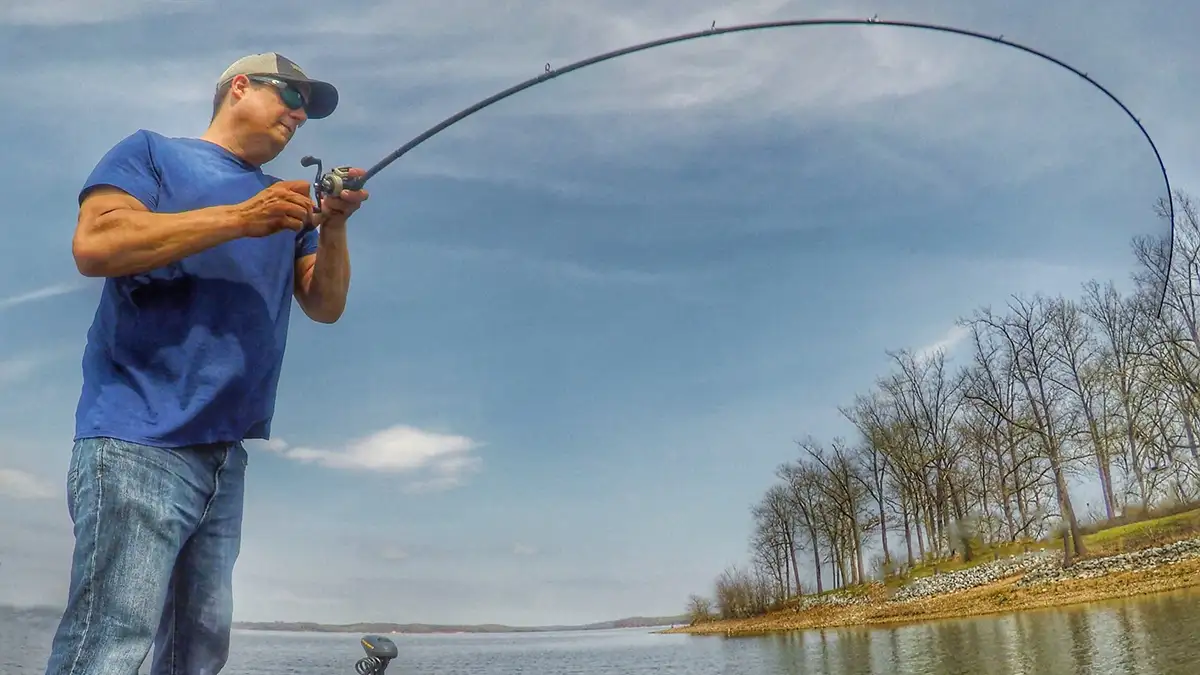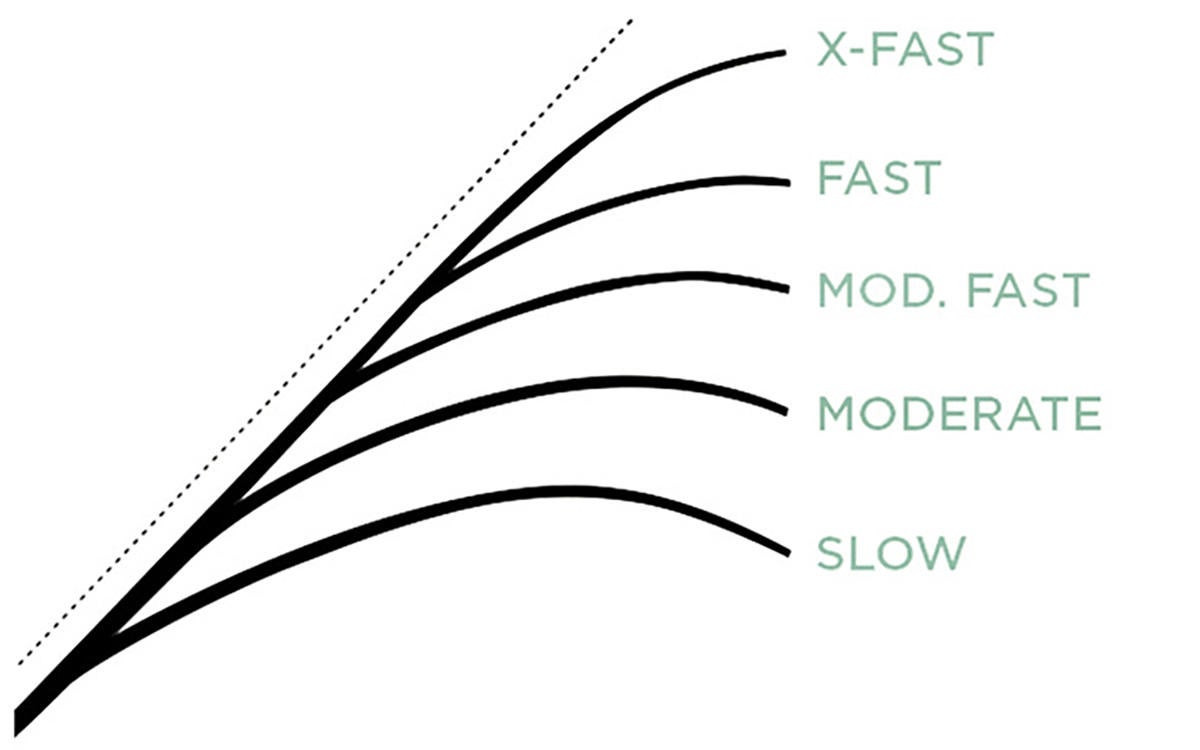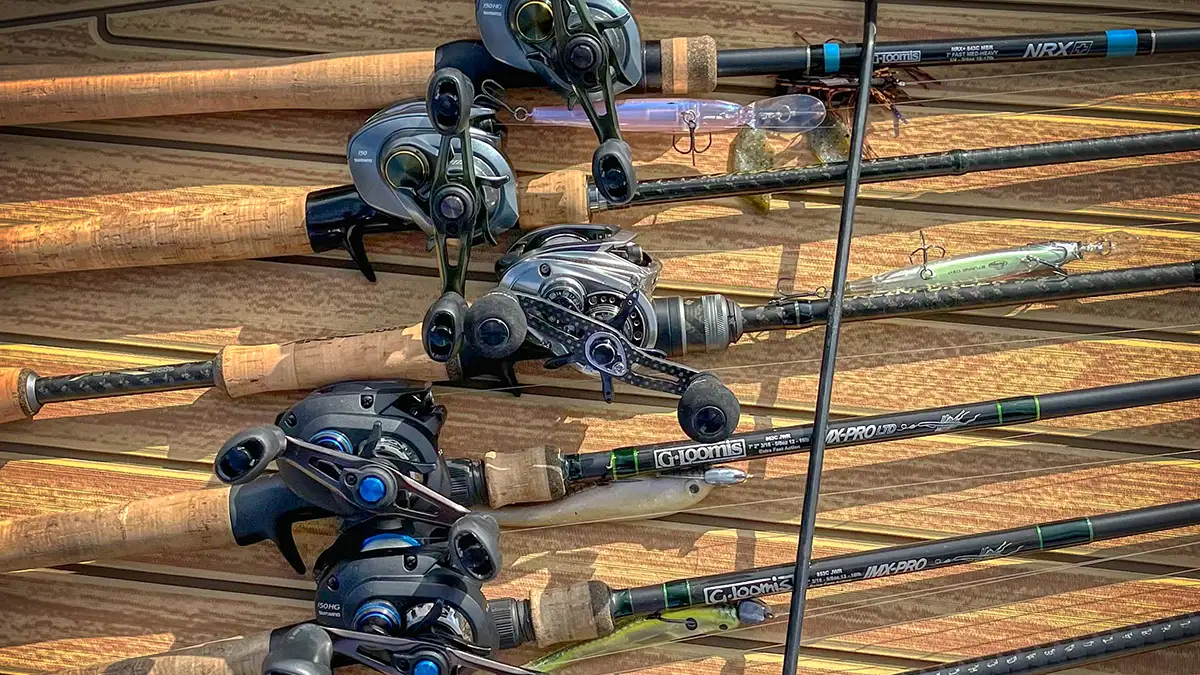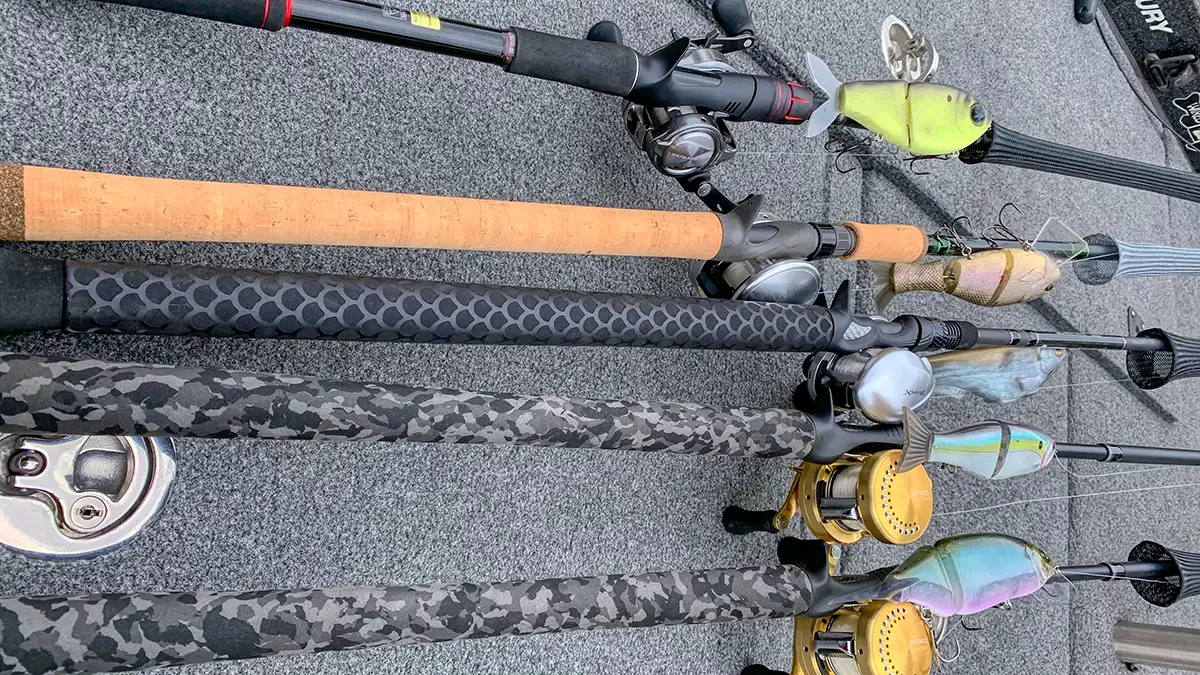Fishing rods vary greatly depending on species and techniques and preferences of anglers and manufacturing techniques. From materials to rod actions and rod powers, a fishing rod can be made in a multitude of different options. Length, power, action, taper and material as well as process can alter weight and balance of rods and that makes for an endless array of options that anglers have to then decipher and make some sort of educated decision on which rod will best fit their needs.
It can be an overwhelming prospect, so we’re seeking to help you understand not only what matters when choosing a fishing rod but also some of our favorite options among all of these choices.
Fishing Rod Actions in Depth
So the terminology for rod actions confuses people. When you think about the action of the rod you’re talking about how much tip movement there is in the rod. So you would think you would have a scale from “stiff” to “limp” right? Because the Extra Fast Action is the stiffest action and the Slow Action is the limpest action.
What the the speed nomenclature is actually measuring is the speed in which rod returns to its normal state. So your fishing rod is straight in its normal untouched state. As the rod loads, it takes on a bent or loaded state under pressure. When you release the pressure, this is the action of the rod.
In other words, when I bend a rod with an extra fast or fast action these are the fastest actions. That means the rod will return to its normal state the fastest. It’s extra fast action. So it returns to normal the extra fast. Whereas, when I bend a moderate to moderate slow rod, and release the pressure, the rod moves back to its normal state a lot slower. So it’s a slow action or a moderately slow action compared to the fast or extra-fast action.
Charting Fishing Rod Actions for Easy Understanding
So the easiest way to show the differences in actions is by charting them. On this chart, you can see that the fast rod doesn’t bend as easy and has a lot less tip movement. So it has the least distance to travel to return to normal. So it will get there the fastest. Hence it’s a fast action.
The slower the action, the more the rod bends into the backbone. More of the rod moves, so it has to travel more distance to get back to straight. So it’s a lot slower to get back to straight.
Parabolic bends are when the action blends with the power of the rod to bend further down into the backbone of the rod where the power forms.
Generally speaking a fast rod is a lot more responsive. It will set a hook a lot better, so it’s more for techniques where you need to drive a hook more on the hookset, like with a worm hook that is buried in plastic. A slower rod is going to load up more and the hooks grab under pressure. So a slower rod is better when you’re talking about straight retrieves and treble hook lures. The fish loads up on the bait when it bites, and the hooks drive under the loaded pressure not a hard hookset.
A faster action is nice when you need to work a lure with the rod like a worm or a jig. Where a slower action is preferred when you work the treble hook lure more with your reel like with a crankbait for example.
Breaking down rod actions
So let’s take a look at each rod action and when you should use them in your fishing.
Choosing Extra Fast Action Rods
A rod that has a super fast or responsive tip is usually best when you need to move the lure with your rod and you need to drive a hook fast when a fish bites. Most of the time an extra-fast action is found on a rod with more backbone like a flipping stick for pitching and flipping for bass.
Or this action is found on a rod like a football jig rod where you’re casting a lure out to deep water and pulling the jig along the bottom by moving the rod. You don’t want a slow rod that is spongy when you’re trying to work a bait and maintain contact with it. And, when a fish bites, you need to drive a hook with a lot of line out which means stretch. An extra-fast action will help with that.
This action pairs nicely with a heavy power rod.
Fast Action Rod Applications
A fast-action rod has a responsive tip but it has a bit more flex. Where I like these types of rods is where you need to cast a lure into tight quarters and work a bait with quick moves of the rod tip. So say working a top water, a jerkbait or something like a hollow-bodied frog. I want a little more tip action to cast the lure accurately but not so much that I can’t work my bait effectively with sharp snaps of the rod.
This action often pairs nicely with a Medium Heavy power.
Medium or Moderate Action Rods
A medium or even sometimes medium fast action rod is used for more straight retrieve type fishing. Things like spinnerbaits, Chatterbaits, and crankbaits fish really well on medium fast to medium/moderate action rods. These types of baits and retrieves lend more to a sweeping hookset where you lean into the fish when it runs a bait down and grabs it from behind. If it’s too fast of an action, you often will snatch the lure away from the fish before they’ve closed their mouth around the lure.
Oftentimes you are wanting a lot more distance with these types of lures, so a moderate action rod loads a lot more and can give you a lot more distance on a cast. A stiffer rod doesn’t load as much and won’t have the launching power that a moderate rod has. Moderate actions work best with medium and medium light powers.
Slow action rod
Slow action rods are not used as much because they can get real spongy and unwieldy on both the cast and retrieving the lure. Some glass and E-glass rods have slow actions and they are better for crankbaits where you want to make long casts and make sure you don’t take the lure away from the fish when they bite. Panfish rods with ultralight powers can have real slow powers too.
Fishing Rod Powers Explained
The power of a rod often refers to how much backbone a rod has. An Extra-heavy power rod has a ton of backbone and can lift bigger fish into the boat and cast larger, heavy lures. Most big swimbait rods are XXH-power rods where most small panfish rods are ultralight rods (UL).
Power combined with action and length gives you technique specific rods. Power aids in hooksets, castability, landability, and even fatigue to an extent. If you’re using a rod too light for the application, you can wear yourself out. If you’re using a rod too heavy for an application, you will have a hard time casting the lure efficiently.
Generally speaking the heavier the power of the rod, the harder it will be to cast, with the exception of casting very heavy lures like big swimbaits. The lighter the rod, the better it will cast lighter lures like crappie jigs.
On the flip side, the heavier the rod, the easier it will be to set a good hook even with large hooks. And the lighter the rod, the harder it will be to drive a large hook so you have to size down your hooks for better penetration with less pressure.
Fishing Rod Power Rating Chart
Rod powers are basically ultralight all the way up to extra-extra-heavy. Some manufacturers like G. Loomis have gone to a power rating number system similar to what fly rods have always used like a 5 wt, a 6 wt or a 9 wt and so on. G. Loomis assigns numbers to their rods like a 845C CBR. The first two numbers are the length in inches of the rod. The last number is the rod’s power. The letters are generally acronyms for the rod, in this case CrankBaitRod.
With bass fishing rods and multispecies rods they basically break down like this following chart:
| Power No. | Power Designation | Applications | Species |
| 0 | Ultralight (UL) | Small jigs, small spinners, small micro baits | Panfish |
| 1 | Light (L) | Small jigs, small spinners, small crankbaits | Panfish |
| 1-2 | Medium Light | Shaky heads, drop shots, small crankbaits, small topwaters, jerkbaits | Panfish, bass, walleye |
| 2 | Medium (M) | Jerkbaits, crankbaits, spinnerbaits, chatter baits, | Bass, walleye |
| 3 | Medium Heavy (MH) | Spinnerbaits, jigs, worms, small swimbaits, spoons, buzz baits, deep diving crankbaits, more… | Bass, Catfish |
| 4 | Heavy (H) | Flipping and pitching, frogging, swimbaits, umbrella rigs | Bass, Catfish |
| 5 | Extra Heavy (XH) | Flipping, punching, frogging, big swimbaits, umbrella rigs | Bass, Catfish |
| 6 | Extra Extra Heavy (XXH) | Large Swimbaits, big fish | Bass, Catfish |
| 7 | XXXH | Baits weighing 10 ounces | Bass, Catfish |
Power, Action, and Length all together make the rod
Understanding that rod power, action and length will dictate the rod’s uses and will help you make a good choice on a rod when you’re buying at a retailer or on a fishing trip. The power and action usually marry up similarly on most rods and small adjustments can give one rod a little different action and sensitivity in certain applications.
A long, 8-foot, medium or medium-heavy rod with a moderate action will be a great deep diving crankbait rod. But that same 8-foot rod with a heavy power and extra fast action tip will be a great punching rod for matted vegetation.
Fishing Rod Material Considerations
When you talk about fishing rods, I think a lot of novice anglers assume all rods are made out of the same material—some form of graphite or fiberglass. But rod materials have advanced a lot in the last 20 years and rods are made of lots of proprietary blends of modern materials.
For a long time all we had was IM6 or IM8 graphite rods. This was actually a proprietary material made from graphite maker the Hexcel Corporation that every one then rolled with their own resins and clear coats to make their rods unique.
Nowadays, manufacturers talk about modulus and tonnage when talking about the stiffness of the graphite. You have high modulus and low modulus rods. You have 30Ton and 40Ton rods and so on.
Beyond that some companies are working with carbon fiber—a lighter and stronger material. Some companies are blending and cross weaving different modulus together in single rods and adding layers of other materials to strengthen back bones and give rods unique actions. The varying processes of blending these materials is what makes some rods a lot more expensive than others with seemingly the same stuff when they are actually vastly different recipes of materials.
Talking Grips and Handles on Fishing Rods
Originally you had cork handles. Then rubber and foam handles. Nowadays we have EVA foam which is a much denser and durable type of foam that can lighten a rod significantly. Cork does well in wet conditions and lasts a long time. New materials like Winn Grips and tacky composite rubber blends made to look like cork are becoming more popular. And some companies like Cashion rods create proprietary grips out of newer materials like carbon fiber weaves.
You have split grip and full grip options in handles. Split grips can reduce rod weight and is why they became so popular. But full grips make two handed casting a lot more comfortable. The longer the handles the more of a fulcrum you can build which is why they are preferred on extra heavy swimbait rods and deep diving crankbait rods where you are trying to load and launch heavy hard baits as far as possible to achieve maximum depth and coverage.
Fishing Rod Guides can reduce weight and add efficiency
There are a plethora of options in guides. Stainless steel, zirconium, titanium, and other materials can be used to create the guides depending on strength and weight reduction required on the rod. Never mind the ceramic and other insert options. There are classic guides and newer micro guides and even more advance guides like MicroWave guides for funneling line on a spinning reel using a step down guide in a guide configuration.
Having more guides gives you a smoother casting and better retrieving rod because you can keep the line off of the rod blank when it bends. On cheaper rods with less guides, the line will actually rub on the blank or worse go beyond the blank and turn sharp edges in the guides themselves which will lead to more break offs on big fish.
Guides can reduce the weight of a rod or give it more durability. Guides can give more fluid management of your fishing line. And guides should be checked often to make sure the ceramic inserts are not damaged which can cause line fray that leads to break offs.
Click here to read 3 Ways to Repair Your Fishing Rod on a Budget
Fishing Rods Q & A
What is a slow action rod good for?
Slower actions are good for fishing with baits that have treble hooks or lures that you straight reel for a vibration like crankbaits, spinnerbaits, lipless crankbaits, Chatterbaits. The rod transmits the vibration well, loads on the back cast to get an extra long cast and then loads up well and gives the hooks time to drive in and hook the fish well. It’s not great for baits you have to impart action on with the rod. A slower action is made for rods that you just straight reel a lure and then lean into the fish when they bite.
What is a fast action rod good for?
A fast-action rod gives you enough tip and backbone to impart action on the lure to make it dance and dart or hop a long the bottom. The rod also is usually a bit stiffer overall so it’s a lot better for lures that require a hard hook set to drive a single hook through plastic and into the fish. So faster actions are seen on rods you need to work the bait like topwaters and jerkbaits, but also on baits you might shake and hop and then have to drive a hook on the bite like jigs and worms.
What is an extra-fast action rod good for?
This is for baits you want to twitch or for very heavy duty rods that you need maximum power and a quick hookset. So a lot of jerkbait and topwater rods have extra fast actions. You also see this in flipping sticks and big swimbait rods.
What is a moderate action rod for?
Normally a moderate action is good for reeled baits where you need a bit of backbone and hooking power. So something like a swim jig, chatterbait rod, and spinnerbait rod will have a moderate action as will some deep cranking rods.
What is the easiest fishing rod to use?
To learn to fish, we recommend starting with a spinning rod with a spinning reel to learn to fish. You pinch the line to the rod, open the bail on the reel and then cast letting your finger off the line to let the lure fly. It’s very simple and quick to learn and will give you a lot of options for fishing. But you learn to work the rod and take up your slack with the reel. Or you can just straight reel and you have a lot of power and leverage with a spinning rod with small baits.
Should I get a 1-piece or 2-piece rod?
Most of the time we prefer 1-piece rods. More uniform construction yields more sensitivity power and durability. But 2 piece rods have their place, especially when you are talking about traveling. We reviewed several of the best travel rods and many were 2-piece rods that offer great fishing in an easy to break down and transport configuration.
So that’s a basic rundown of everything you need to know about fishing rods to make good decisions on which rods to buy and use for your various fishing scenarios. To learn more about specific rods we’ve tested and like, visit our Best Fishing Rods article.















